More Than One G-mail Account?
Some people have more than one G-mail account. Maybe one is used for personal messages and the other is for business messages. One of mine is a stand-alone account and the other is a mirror of all mail sent to my personal accounts. If you have more than one account, you know that you can't have both accounts open in the same browser. But there's one problem with that: It's no longer correct. Setting up a second (or third) account in the same browser is easy and I can show you how.
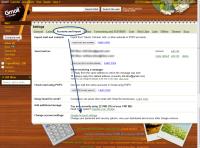 To use this feature, you'll need to locate some obscure settings and agree that you understand the implications of making the change. Start by clicking Settings, then choose the Accounts and Import tab. Now scroll all the way to the bottom of the page and click Google Account Settings.
To use this feature, you'll need to locate some obscure settings and agree that you understand the implications of making the change. Start by clicking Settings, then choose the Accounts and Import tab. Now scroll all the way to the bottom of the page and click Google Account Settings.
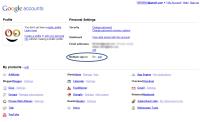 You should now see a Multiple Sign-in option. The feature will be shown as "off". Select the Edit option.
You should now see a Multiple Sign-in option. The feature will be shown as "off". Select the Edit option.
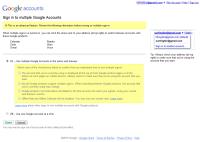 On this screen, you enable the option and explicitly state that you understand what will happen as a result of the change. Be sure that you understand some features you used previously may no longer be available.
On this screen, you enable the option and explicitly state that you understand what will happen as a result of the change. Be sure that you understand some features you used previously may no longer be available.
![]() Once you've enabled multiple accounts, you may need to sign out of the account and sign back in to see the change. I just refreshed the page. Now you'll have a down-arrow to the right of your account name at the top of the screen. Click this to change accounts.
Once you've enabled multiple accounts, you may need to sign out of the account and sign back in to see the change. I just refreshed the page. Now you'll have a down-arrow to the right of your account name at the top of the screen. Click this to change accounts.
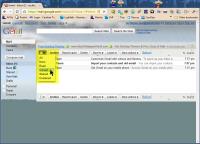 That's not all that's new, either. You'll find some subtle changes. Selecting groups of messages (all, none, read, unread, starred, un-starred) no longer takes up space in the margin. Now these choices are on a drop-down list. That made space for Mail, Contacts, and Tasks at the top of the left column and Compose Mail is now a more visible button instead of a text link. If you look very carefully, you'll see that the header is 16 pixels shorter, which doesn't make much difference on a high-res screen.
That's not all that's new, either. You'll find some subtle changes. Selecting groups of messages (all, none, read, unread, starred, un-starred) no longer takes up space in the margin. Now these choices are on a drop-down list. That made space for Mail, Contacts, and Tasks at the top of the left column and Compose Mail is now a more visible button instead of a text link. If you look very carefully, you'll see that the header is 16 pixels shorter, which doesn't make much difference on a high-res screen.
Google has also updated the Contacts section and added some requested features:
- Contacts work a lot more like Mail and keyboard shortcuts work in Contacts.
- You can now sort contacts by last name.
- If you want to change the labels for phone numbers and other fields, now you can.
- Undo is now available so, if you make an incorrect change, you can quickly revert to the previous version.
- Edit and View modes no longer exist. When you make a change, G-mail automatically saves the change.
One of the more interesting sections of G-mail (and the other Google applications) is the "Labs" area. As Google describes it, "G-mail Labs is a testing ground for experimental features that aren't quite ready for prime time. They may change, break or disappear at any time."
I found a few interesting tidbits on the lab's shelves.
 Canned Responses: This is for people who routinely need to send the same message to people. Write the message once and send it with just a few keystrokes. You can even have a G-mail filter send one of these messages.
Canned Responses: This is for people who routinely need to send the same message to people. Write the message once and send it with just a few keystrokes. You can even have a G-mail filter send one of these messages. Custom Date Formats: I like 24-hour clocks. There's no ambiguity about the time when it's stated this way and it takes less space than the 12-hour format with am and pm added.
Custom Date Formats: I like 24-hour clocks. There's no ambiguity about the time when it's stated this way and it takes less space than the 12-hour format with am and pm added.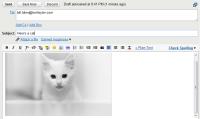 Inserting Images: Sometimes I like to include an image in a message. This hasn't always been easy with Google. This lab function fixes that.
Inserting Images: Sometimes I like to include an image in a message. This hasn't always been easy with Google. This lab function fixes that.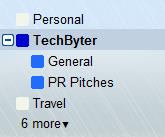 Nested Labels: If the basic single-level labels are insufficient for your needs, choose this option and you can add a hierarchy of labels.
Nested Labels: If the basic single-level labels are insufficient for your needs, choose this option and you can add a hierarchy of labels.
Your Computer's Biggest Fan
Heat is one of your computer's biggest enemies and many computers have less cooling capacity than they really need. A question from Hawaii reminds me that it's not as easy as just opening the case and adding a fan.
A question from Hawaii: I feel much more at home with the new computer since I opened it up and looked inside. However, I was gobsmacked to see that there was no rear fan. There's a grille -- there are holes for attaching a fan -- but no fan. A friend suggested that there might be a fan under the graphics card, which indeed there is. So, no front vents, just a big grille on the side. Air comes in, is circulated by the graphics fan, and then goes out the grille in the rear. There are also CPU and power supply fans.
I'm thinking of attaching a fan to the rear, just to improve air circulation in this hot tropical climate. The case designers must have envisioned this possibility, as there are holes for attaching the fan. Yet ... I'm wondering if I run the risk of messing up the air circulation in some unforeseen way by adding the fan.
What do you think?
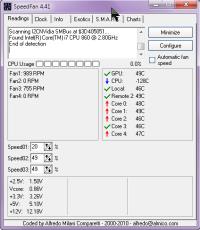 GPUs generally have fans now, particularly the more powerful ones. As for adding a fan, first find out if you really need one. Download Speed Fan (free).
Run this application (stay away from the panels that allow you to overclock things) and see what the temperatures are inside. If they're pushing the high end of what's acceptable, adding a fan would be a good idea.
GPUs generally have fans now, particularly the more powerful ones. As for adding a fan, first find out if you really need one. Download Speed Fan (free).
Run this application (stay away from the panels that allow you to overclock things) and see what the temperatures are inside. If they're pushing the high end of what's acceptable, adding a fan would be a good idea.
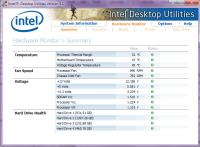 Or, if you have an Intel motherboard and CPU, take a look at Intel's Desktop Utilities application. There's no charge for the application. More accurately, you paid for it when you bought the motherboard, so you might as well download it. One feature I like about this application is that it can run in the Tray and it will alert you immediately if something starts operating out of spec.
Or, if you have an Intel motherboard and CPU, take a look at Intel's Desktop Utilities application. There's no charge for the application. More accurately, you paid for it when you bought the motherboard, so you might as well download it. One feature I like about this application is that it can run in the Tray and it will alert you immediately if something starts operating out of spec.
But then you need to determine whether the power supply can handle it. If the components in the PC require a 125-Watt power supply, you can be sure the manufacturer didn't install a 250-Watt power supply. There won't be a lot of headroom.
If there's enough power to add it, you might install a rear fan as an exhaust fan and then add some filtering material to the grille(s) to keep dust and cat fuzz from being ingested. My home computer came with a removable screen and the interior stays much cleaner now.
What Happened to MTBF?
I was looking at the specifications for some new Seagate hard drives (the Momentus series) when I realized that no rating for MTBF was stated. That's "mean time between failure". Some manufacturers have stated MTBF figures that seem fanciful at best. The fact is, though, that hard drives are a lot less likely to fail than in the past. That doesn't mean you can skip backup, but it does mean that your chance of suffering a catastrophic failure is a lot less than in the past.
The average SATA drive has a MTBF of 600,000 hours or so, although Western Digital rates some of its drives at 1.4 million hours. The problem with MTBF is that it's essentially a theoretical lab analysis based on drives that are operated in laboratory environments. MTBF figures are used before a product is in production. Once drives are in production, a better measure of failure is the annualized failure rate (AFR). That's the number Seagate cited.
According to Seagate, the AFR for its Momentus line of hybrid hard drives is 0.5%. That's an astonishingly low rate: One half of one percent of the drives will fail per year. If one can extrapolate from there, and I'm not sure that one can, 100% of the drives could be expected to fail within 200 years. I would expect failure much sooner than 2210 for a drive bought this year.
Something tells me that the AFR really isn't a straight line. As mechanical devices age, they are more likely to fail. But what if we consider just the next 10 years or so. Is there really a 95% chance that your hard drive will continue to function a decade from now? When the hard drive was invented (December 1954) it's unlikely that anyone foresaw a time when drives could be expected to run for a decade or more.
But they do. And they're becoming even more reliable in addition to becoming larger, faster, and less expensive.
Even the drives in the Seagate Momentus series, which are considerably more expensive than non-hybrid drives, are reasonably priced: 500GB ($150), 320GB ($115), and 250GB ($100). Standard 1000GB hard drives are selling for about $75 and 2000GB drives for around $100, so you're paying for something extra if you buy a Momentus drive.
The Momentus series drives aren't solid-state drives and they aren't standard drives. They are "solid-state hybrid" drives with what Seagate calls "adaptive memory" technology. You can watch a Seagate engineer explain the new technology.
The "Adaptive Memory" technology monitors your frequently used applications and data files, then places them into the solid state portion of the drive so they can be quickly recalled. This makes sense for 2 reasons: First, you want the applications you need most often to be available as quickly as possible; and second, the SSD part of the drive can perform a limited number of write cycles, so you want to store here the components that change infrequently. Applications, for example.
Short Circuits
Intel Antivirus
"Huh?" That seems an appropriate response to the news that Intel has purchased antivirus company McAfee for just under $8 billion. The goal is to build in more security to the hardware and to shut out the other software security vendors. Intel has shown itself to be a master at games like this.
Intel CEO Paul Otellini says the acquisition will "better protect Internet users and their devices." Translation: Intel will try to force competing products out of the marketplace by tying antivirus operation to the hardware. Intel's stock price dropped after the announcement and McAfee's shares rose.
Intel will pay $48 per share for the company. That's more than 1.5 times what the stock is selling for now. McAfee is the #2 player in the antivirus space with less than 20% of the market compared the leader Symantec with more than 35% of the market.
Intel may be looking to increase its presence in markets other than those for notebook and desktop computers. The company already includes some security functions in its CPUs. The McAfee acquisition gives the company access to specialists who understand the threats.
Watch for Intel to pursue non-computer growth. The company appears to be on a path to place hardware in the smartphone market and possibly in other consumer markets.
Google Retreats in Germany
Germans are concerned by Google's Street View feature. So concerned, in fact, that Google says they can opt out of having their residences shown. The requests would need to be made within 4 weeks, Google said. There was significant push-back from Germans, so Google has increased the time to 8 weeks.
What happens if you live on the 53rd floor of a high-rise and don't want your residence shown, but nobody else in the 75-story building complains? What happens if your home is on the north side of the street and someone on the south side of the street objects? Google probably has this all figured out, but one can imagine a lot of odd situations.
Google plans to introduce Street View in Germany's 20 largest cities before the end of the year according to Google VP for Northern and Central Europe, Philipp Schindler. The cities would, presumably be a kind of Schindler's List. (Sorry) "We were aware of the fact that 'Street View' could lead to discussions in Germany," Schindler said.
Street View is available in 23 countries and this is the first time Google has made it possible for individuals to opt out. The online tool that Germans can use to opt out of the service went online August 16th.
Trusted Sites May Harm Your Computer
According to InformationWeek author Mathew J. Schwartz, up to 5 million domains parked by Network Solutions are actively serving threats. The article quotes employees of Web application security vendor Armorize Technologies, which traced the malware to a widget being offered by Network Solutions. Network Solutions has removed the widget, but Armorize president Wayne Huang says the malicious software is "part of the standard domain parking page of Network Solutions."
How many law firms are already preparing class action lawsuits?
The threat could affect between half a million and 5 million websites that are "parked" by Network Solutions. TechByter Worldwide is hosted at BlueHost in Orem, Utah, and is not associated in any way with Network Solutions.
Information Week quotes Network Solutions Director of Public Relations, Susan Wade: "The widget link that appeared on the parked page master template has been removed, therefore the widget no longer appears on any Network Solutions' parked page."
Network Solutions disputed the number of affected websites but also recommended that anyone who added the GrowSmartBusiness widget to a website should delete that widget and scan your site for malware.
Nikon Joins the Video Party
A new digital SLR from Nikon, the D3100, is capable of shooting 1080p high-definition video. That, of course, is in addition to high-quality still digital images. The D3100 is the successor to last year's D3000. It has a 14.2 Mpxl CMOS sensor and is the first digital SLR that offers continuous auto-focus during video recording. The camera also can be used to record 720p video.
Auto-focus during video operation has been a problem for digital SLRs because the focus mechanism on the lens is usually too noisy for use while audio is being captured.
Operating in 1080p mode, the camera can record video at 24 frames per second and at 720p it can record at 24 or 30 frames per second.
For still photographers, new image processing allows the ISO range to 12,800. This kind of speed allows use in extremely low light conditions without flash. The D3100 will be available in mid September and has a price of $700 with an F-S Nikkor 18-55mm f/3.5-5.6G VR kit lens. The lens choice is one way Nikon has managed to keep the price down.


 The author's image: It's that photo over at the right. This explains why TechByter Worldwide was never on television, doesn't it?
The author's image: It's that photo over at the right. This explains why TechByter Worldwide was never on television, doesn't it?
